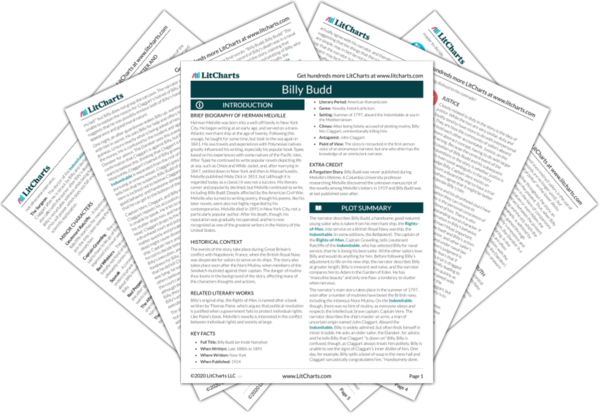Natural Character and Appearance
Billy Budd begins with a lengthy description of the type of person known as the "handsome sailor" and the story's narrator often takes time away from the story to describe characters like Captain Vere or Claggart at length. As this suggests, the narrator of the story tends to see character as innate: people are either fundamentally good and innocent (like Billy Budd) or fundamentally sinister and bad, like Claggart. Thus, it is important for…
read analysis of Natural Character and AppearanceDuty, Loyalty, and Camaraderie
Within the naval world of the story, almost nothing is more important than the camaraderie among sailors on the same ship and their loyalty to their captain. The close bonds between fellow sailors can be seen in the example of the handsome sailor that the narrator describes early in the story (surrounded by his proud, admiring comrades), as well as the reluctance with which the captain of the Rights-of-Man lets Billy go. In addition to…
read analysis of Duty, Loyalty, and CamaraderieJustice
Closely related to duty in the story is the idea of justice. While the two are very similar, duty and loyalty tend to have more to do with interpersonal relationships. They are how the community of sailors aboard the Indomitable hold each other accountable. Justice, on the other hand, is a more abstract concept, having to do with larger issues of right and wrong. Because the central event of the story is the false accusation…
read analysis of Justice
Individual vs. Society
The story's questions of duty and justice often center around a conflict between an individual and society. In deciding Billy's fate, for example, Captain Vere must decide between his own personal admiration of Billy's character and what may be best for the ship's community and the navy as a whole, as enshrined in naval law. And the entire story is set in the context of the royal navy, where sailors have all devoted their individual…
read analysis of Individual vs. SocietyThe Present vs. the Past
The narrator of Billy Budd often contrasts the present time of his story with the glorious past—for example, as he admiringly describes the valiant service of Admiral Nelson and laments the introduction of guns and ironsides to naval combat. For the narrator, earlier forms of naval combat were more poetic and honorable. In his own time, the master-at-arms does not even instruct sailors in the use of weapons anymore (since swords are no longer used)…
read analysis of The Present vs. the PastStorytelling, Rumor, and Truth
The clash between false rumor and truth is central to the plot of Billy Budd. The story turns on the false rumors that Claggart makes up and reports to Captain Vere, while Vere must decide between the truthfulness of Claggart's and Billy's stories. The distinction between truth and rumor is thus a matter of life or death for both Claggart and Billy. Moreover, the very story of Billy's tragic death is caught between…
read analysis of Storytelling, Rumor, and Truth











